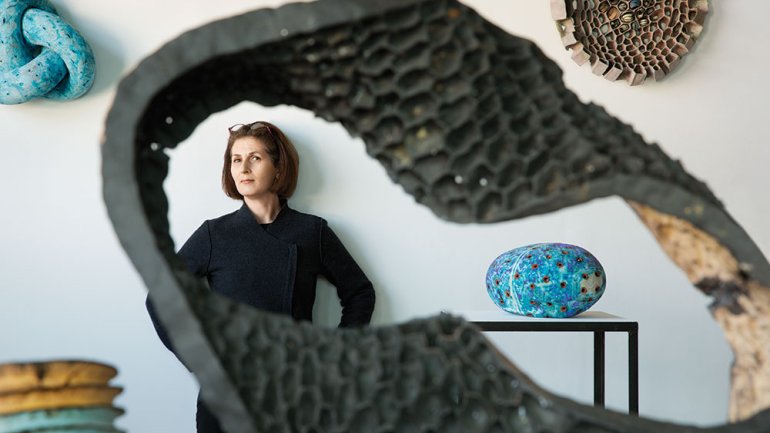Quiet Language
Quiet Language
Two summers ago, after years of making ceramics in her basement, Judit Varga was thrilled to find a big, bright new space to rent in an old industrial building near her home in North Bethesda, Maryland. But it was the view out the window that made the place seem destined for her: Not the mountains or the ocean of her dreams, but an odd, hive-like hangar that stores the county’s supply of salt for the roads in wintertime.
“The shape is exactly my Blue Cocoon – it’s ridiculous,” Varga marvels, referring to a sculpture in her latest and, to date, most personal series of work. “It’s an amusing coincidence, maybe part of my fate – who knows? But I like the view. And right behind it, the train runs by as a daily reminder of passing time.”
Change, movement, metamorphosis. All that is on Varga’s mind as she embraces a new, richly creative stage of her life. A native of Hungary, she became an American citizen in 2011 and is feeling content and fully at home in her adopted country. And at 49, with two daughters almost grown, she’s in a good place, literally and figuratively. She’s working in that spacious, light-filled studio with clarity and assurance, making her best, truest work yet: sculptural vessels, knots, pods, squares, cylinders, and cubes, sometimes arranged in still lifes or wall installations, with organic surfaces in rich, muted shades – earthy rust and ochre, deep cobalt, murky brown and gray.
They have been warmly received at the American Craft Council Baltimore Show and the Philadelphia Museum of Art Craft Show, among other venues, and one of her cocoon-like pieces – “my new thing” – earned a merit award in the prestigious San Angelo National Ceramic Competition last year, judged by ceramics connoisseurs Garth Clark and Mark Del Vecchio.
“I really like the idea of this form in nature, this shape with a huge change happening inside,” Varga says of the cocoon.
“After a while, a beautiful creature comes out, and what’s left behind is the memory or byproduct of this change.”
For Varga, the cocoon speaks to her journey as a woman and an artist. She grew up around ceramics, in a Hungarian town near the Austrian border. Her father worked as an engineer at the local pottery factory, and had a studio at home where he worked with clay in his spare time. She majored in art and mathematics at a teachers college and later took up ceramics as a student at the Moholy-Nagy University of Art and Design in Budapest, where she also reconnected with her high school sweetheart. In 1993, his work in medical research brought the couple to the United States. They settled in the Washington, DC, area a year later.
As she adapted to life in her new country, Varga tried to continue her ceramic work, but soon had two small children and felt unable to focus on her art. “I have to have time where I can get lost in the material. I made a conscious decision to completely stop.” And for eight years she did, with the exception of a few forays into clay during summer trips back to Hungary.
By the time she was ready to resume in earnest, in 2006, she had a fresh perspective, pent-up creativity, and a determination to reclaim her identity. “People saw me, or defined me, as a mom with an accent, or something like that. It was silly, but I wanted to prove that I am an artist – that I’m good at something.”
Art also gave her a much-needed means of expression. Varga speaks excellent English (flavored with a touch of Eastern Europe), but it’s not the same as her native tongue.
“Talking about important stuff, like my art, is very sensitive. I had to find a quiet language to communicate with the outside world. Through clay, I can be what I want to be here.”
She struggled at first to rediscover her voice. “I was running in circles trying to find my ‘style’ in clay,” she recalls. “I was lost. Suddenly, it was like, ‘Why am I doing this? I should just do what I like to do.’ ”
Drawing on her background in mathematics, a universal language, she settled on three shapes – circle, square, and knot – as her basic vocabulary. “That’s plenty for me,” she says. “I find it powerful that with very simple elements you can put out much meaning, so many thoughts, without words. Without an accent, you know?”
Each piece begins as a thick, flat clay slab, which Varga stretches out on a concrete floor or wooden board to create surface tension. Sometimes she’ll punch holes to add texture or to make the walls of the finished piece look inviting instead of impenetrable.
While the clay is still wet she adds colored slips, creating a malleable body whose surface is already finished (rather than decorated later, when the clay is hardened, though she’ll sometimes do that, too).
“It gives me tremendous freedom to make my shapes,” Varga says. “The color is cohesively bonded to the clay body from the beginning, and it’s behaving naturally all the way to the end, as one material.” The holes and other markings move and stretch as she cuts, bends, twists, coils, and builds the clay into three-dimensional forms.
Her biggest challenge, she says, is “not going too far and losing the clay. Finding that moment when you stop. It’s like how far you can take a situation, be a little bit dangerous, but still stay alive.”
Letting the material be itself and do what it does, allowing its qualities to shine through – in a way, it’s the same thing Varga has been seeking, and finding, for herself. Change may be inevitable, but for now, she’s in the moment.

